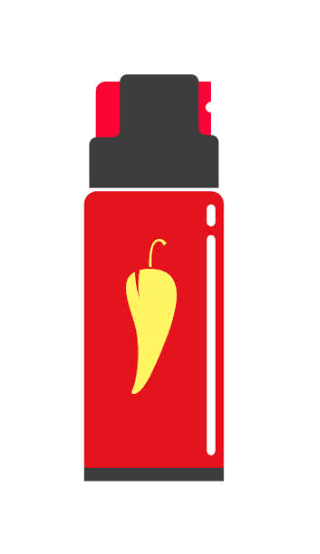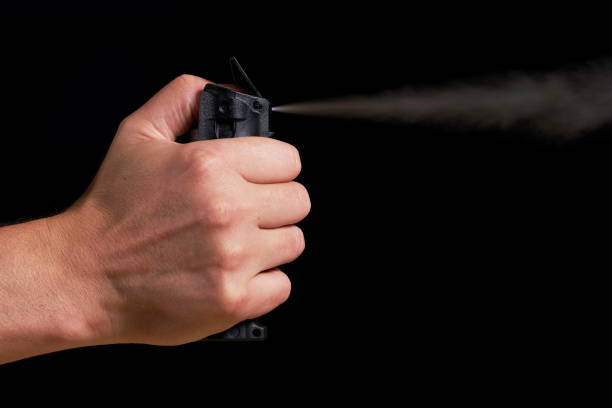Pepper spray is a popular choice when it comes to self-defense weapons. This non-lethal substance allows you to deter your attacker and gives you the chance to escape. Its effects are temporary and last long enough for you to be able to escape or seek help. One common concern for many people is how long this substance stays on surfaces.
The duration that pepper spray stays on a surface relies on a couple of factors. They include the type of surface, the type and concentration of the pepper spray, as well as environmental conditions. You need to understand these factors in order to be able to determine how to clean and get rid of pepper spray on your surface.
In this article, we focus on the types of surfaces and how they affect the duration of pepper spray staying on it. We will also consider how environmental conditions affect the longevity of pepper spray on surfaces.
Factors that Affect the Longevity of Pepper Spray on Surfaces
It’s not uncommon for pepper spray to land on various surfaces. Whether it’s in your home or outside, you need to understand how long it lasts as well as how to get rid of it. Several factors determine how long pepper spray lasts on different surfaces. They include;
1. Type of Pepper Spray
There are different brands and types of pepper spray in the modern day. Each of these has its own concentration and formulation. This is what determines how long a specific pepper spray will last on a surface. The potency of pepper spray also dictates its longevity on a surface. The higher the concentration of a certain pepper spray, the longer it will last.
2. Type of Surface
The texture and material of a surface largely affects how well the formulation of pepper spray adheres. Porous surfaces such as carpets and rugs make it harder to remove thus lasting longer. This is because these materials absorb the substance. Non-porous surfaces such as glass are smooth making it easier for the substance to sit on it. You can easily clean glass and metal.
3. Application Technique
How pepper spray is sprayed affects how it covers and adheres to a surface. If pepper spray is properly aimed and directed with force onto a surface, then there is more likelihood for it to stick. If you spray pepper spray from a distance and inconsistently, it may disperse in the air and not reach the intended target. This makes this surface easier to clean.
4. Temperature and Humidity
Environmental conditions such as temperature and humidity play a role in the longevity of pepper spray on a surface. Hot areas accelerate the rate of evaporation of the particles found in pepper spray. This reduces the longevity of pepper spray on the surface since not all the pepper spray will land on the surface. Cooler temperatures prolong the duration of the spray. One common question people ask is, does pepper spray linger in the air? The answer is yes. However, it eventually evaporates depending on the humidity.
5. Duration of Exposure
The longer you let pepper spray linger on a surface, the longer it lasts on it. This is because with longer exposure, the particles penetrate the surface more and it becomes even harder to clean it.
6. Cleaning Methods
The tactics you use while cleaning pepper spray affect how long it lasts on a surface. Cleaning the area promptly works to ensure you get rid of the substance quickly. However, by using the wrong products, you may worsen the situation and spread the substance even further.
It’s important to be very cautious when cleaning to avoid contamination and further spreading. Use gloves and other protective gear.
Types of Surfaces and How They Affect Pepper Spray Longevity
Pepper spray adheres differently depending on the surface it has been sprayed on. This will affect how long it lasts as well as how to clean it. Here are some common types of surfaces and how long pepper spray may last on them;
1. Porous Surfaces
Porous surfaces are materials that have small pores or holes in them. These surfaces include upholstery, fabrics, and carpets. These materials tend to absorb the pepper spray particles masking it harder to remove. Once you spray pepper spray on these materials, the capsaicin tends to penetrate the pores and it can last longer. In case this happens, ensure you take immediate measures to minimize the effect and prevent it from spreading further.
2. Non-Porous Surfaces
These kinds of materials lack pores or holes. They include plastic, glass, and metal. These materials do not absorb pepper spray. The substance rests on top of them making it easier to clean and get rid of. However, due to their smoothness, it’s easy for pepper spray to spread over a larger surface. This will require thorough cleaning to completely get rid of.
3. Wood Surfaces
Wood surfaces fall under the category of porous surfaces. Due to their porous nature, these surfaces allow pepper spray to penetrate. They retain the residue and make it hard to remove. You must ensure you are careful when cleaning wood surfaces to avoid moisture absorption or further damage.
4. Painted Surfaces
Painted surfaces, specifically ones with a matte finish or are porous are severely affected by pepper spray. The Capsaicin found in pepper spray can react aggressively with the paint. These reactions cause discoloration of the paint, staining and even deterioration. Prompt and correct cleaning is the best way to minimize these effects and reduce the longevity of pepper spray.
5. Outdoor Surfaces
Does pepper spray stay on surfaces? Outdoor surfaces that have been exposed to cement, brick, or concrete have a tendency of allowing pepper spray to linger on them. Due to their rough texture, these surfaces trap pepper spray. This makes it hard to clean.
Regardless of the surface, it’s important to ensure you clean promptly. This ensures that the pepper spray does not linger on the surface for longer. Longer exposure will increase the duration that the pepper spray stays on the surface.
Conclusion
When it comes to self-defense, pepper spray is high on the list of most people’s choice. This non-lethal weapon is effective and its effects are temporary. It’s common for this substance to come in contact with various surfaces. The duration of this pepper spray lasting on a surface depends on a couple of factors. Once you understand these factors you can determine how well to remove it and how long it will take you. The most common of these factors include the type of surface, the type of pepper spray, as well as environmental conditions. Use these factors to help you determine how to use specific cleaning products to get rid of them.

Written by: Georgina Njoki
Freelance Copywriter and Travel Enthusiast.
LinkedIn


